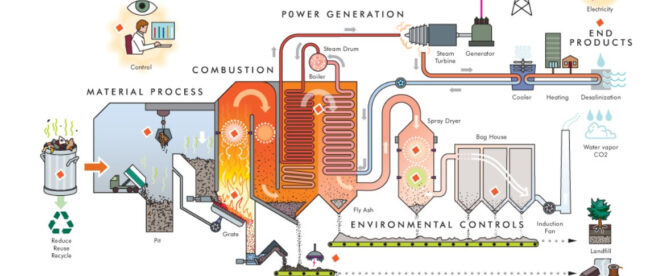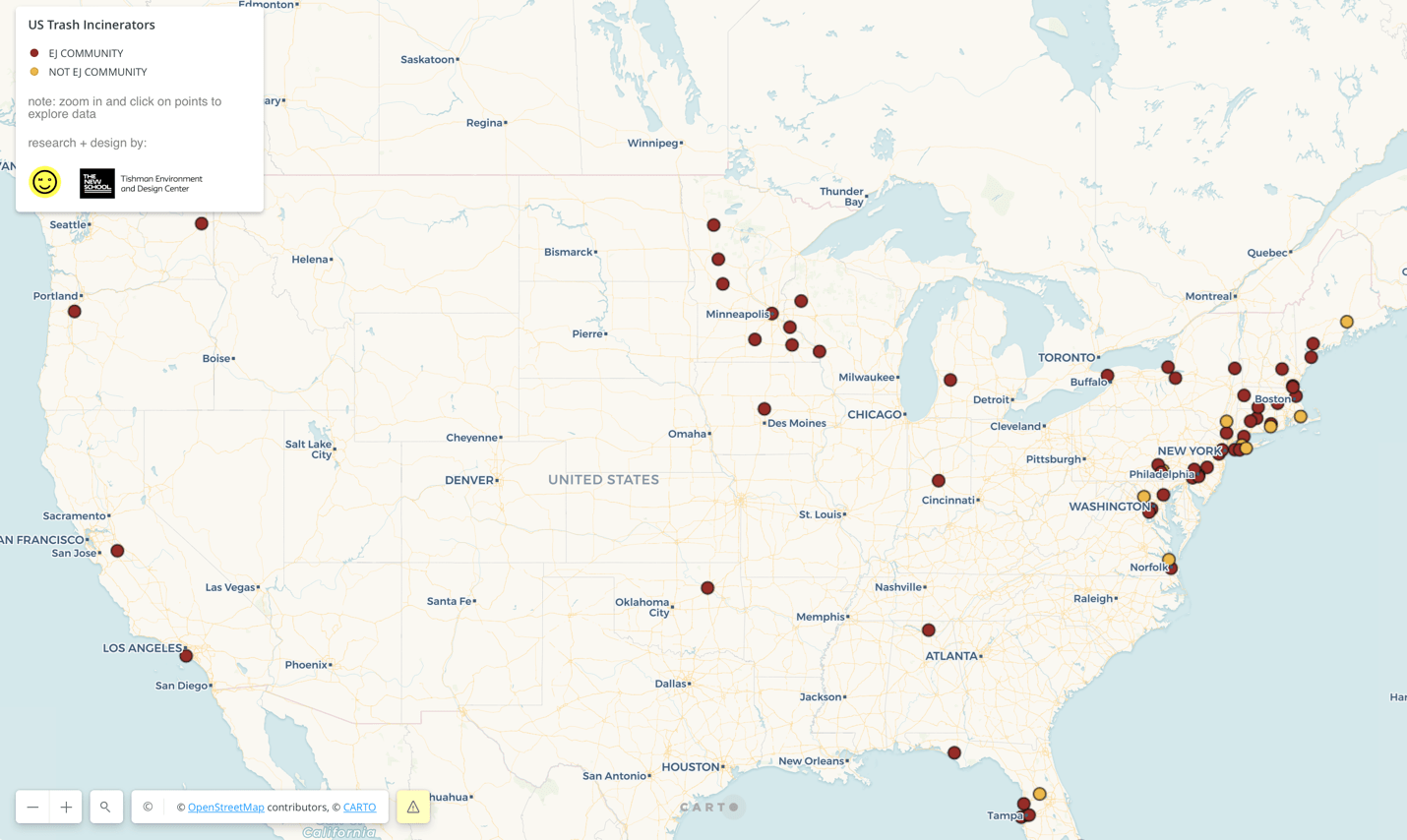Burning Issues: Exploring the EPA’s New Rule for Trash Incineration

(Source)
On Jan 11, 20024, the EPA proposed a new rule with a more stringent air pollution standard for large waste plants that burn municipal solid waste. The newly proposed standard by the EPA would apply to the 57 facilities across the nation that can burn more than 250 tons of waste per day. The new standards aims to reduce emissions of nine pollutants, including smog- and soot-forming sulfur dioxide and nitrogen oxides by around 14,000 tons per year which will in turn improve air quality for communities living near these facilities.
Why Should We Care About The “Burning” Issue?
Although landfills have long dominated the scene of U.S. waste disposal landscape, waste to energy incineration (WTE) is a growing trend. WTE plants are a form of waste incineration thatuses household garbage as fuel for power generation, similar other power stations using coal, oil, or natural gas. Combustible waste generates heat, which is used to boil water and produce steam. This steam then drives a turbine to generate electricity (for specifics see diagram above).
However, waste incineration is a key source of toxic agent emissions. According to EPA’s estimation, incinerators in the United States emitted nearly 50,000 tons of nitrogen oxides, 4,600 tons of sulfur dioxide, 3,200 tons of hydrogen chloride, 780 tons of particulate matter, 15 tons of dioxins/furans, 5.5 tons of lead, 2.3 tons of mercury, and 0.2 tons of cadmium.
Waste to energy incineration causes pollution and negative health impacts in surrounding communities and beyond. Direct exposure to the toxin agents endangers facility workers and residents in nearby communities, increasing the risks of cancers, birth defects, and other adverse health impacts. Moreover, indirect exposure of the toxic agents through the food chain poses global risks beyond the surrounding communities. Notably, outdated incinerator technology and irregular maintenance routines have been closely associated with negative health impacts. Although there are less adverse effects reported associated with more recent incinerators, concerns arise due to time lag and damages may emerge later.
Given the pressing concerns, lawmakers should apply the precautionary principal to incinerators pollution standards. Although there are uncertainties regarding the precise health risks associated with incineration emissions, the lack of conclusive scientific certainty should not be used as an excuse to postpone preventative measures.
A relic of historical environmental injustice?

Waste incineration is as much a socioeconomic issue as it is environmental. Nearly 4.5 million people in the United States are exposed to pollution from waste incinerators, and 85 percent of waste incinerators are located in lower- income communities and/or communities of color. Many of the communities where incinerators are located are already experiencing pollution from other industrial sources, causing cumulative impacts. Hence, the existence of waste to energy plants disproportionately impact marginalized communities. 10 of the 12 incinerators that emit the greatest quantities of lead annually, are in environmental justice communities. This is the result of “historic residential, racial segregation and expulsive zoning laws that allowed whiter, wealthier communities to exclude industrial uses and people of color from their boundaries.”
The new rule from the EPA seeks to redress the issue of historical environmental injustice, particularly when it comes to incinerators that disproportionally affect marginalized communities.
How did we get this new rule?
The new rule falls under the Clean Air Act, originally enacted in 1963, which intends “to protect and enhance the quality of the Nation’s air resources so as to promote the public health and welfare and the productive capacity of its population.” The Clean Air Act does not require the EPA to eliminate health risk, but the EPA has the responsibility to reduce risks “sufficiently” to protect public health with an “adequate margin of safety”.
In the case of solid waste incineration, Congress added section 7429 to the Clean Air Act in 1990 to address industrial air pollution, which requires the EPA to “establish performance standards and other requirements” for solid waste plans. The standard should include “numerical emission limitations” for “particulate matter (total and fine), opacity (as appropriate), sulfur dioxide, hydrogen chloride, oxides of nitrogen, carbon monoxide, lead, cadmium, mercury, and dioxins and dibenzofurans.” The statute clearly identifies municipal waste combustors with a capacity greater than 250 tons per day to be ‘large plants’ subject to the shortest deadlines for promulgating regulations. The EPA is required to promulgate the standards for these large combustion plants (incinerators) within 12 months of the enactment of the 1990 amendments. After promulgation of the initial standards, EPA then must “review and . . . revise” all such standards, including the large MWC standards, “[n]ot later than 5 years following the initial promulgation of [the] performance standards and other requirements under this section . . . and at 5 year intervals thereafter.”
However, EPA has consistently failed to meet its deadlines to review and revise the large MWC standards. The last version of the rules are from 2006, and since then the EPA has not been able to propose nor finalize a new rule. Thus, EPA failed to fulfill a non-discretionary duty under the Clean Air Act. Environmental Groups, including Earthjustice, the Sierra Club, East Yard Communities for Environmental Justice and Ironbound Community Corp., sued the EPA in January 2022 over its alleged failure under the Clean Air Act to revisit the rules every five years. The decree would require EPA to finalize a new rule by November 30, 2024.
Ultimately, the lawsuit is a component of a larger campaign by environmental groups. The lawsuit shows the crucial role of citizen led actions in regulatory enforcement, supplementing and accelerating government enforcement. To solve the pressing issue of environmental harms from incinerators, updating the emission standards is only the beginning, not the end. Aside from updated emission standards, we also need more effective enforcement for incinerators that fails to meet the standards.
Do New Emissions Rules for Incinerators Go Far Enough?
The rule not only establishes new standards for various pollutants but also simplifies the standard for nitrogen oxides and updates the requirements for continuous monitoring of nitrogen oxides, sulfur dioxide, and carbon monoxide. The updated requirement for continuous monitoring requires emission data to be collected and reported whenever the large MWC unit is operating, including startup, shutdown, and malfunction times, which have been sources of spiked emissions. The updated monitoring requirements should increase reliability and avoid underestimation of emissions.
While the new rules are more stringent than any previous standards, concerns remain. The new standard affects 57 of the 66 commercial trash incinerators operating in the U.S. However, some facilities will not need to adjust their technology because they already meet the new standards, according to the Energy Justice Network.
The pollutant limits set under the Emissions Guidelines are less strict than those for new sources. For example, new facilities would be required to limit NOx emissions to 50 parts per million, while existing facilities would be required to limit NOx emissions to 110 parts per million. Previously, these limits were set at 150 and 180-250 (based on facility type) in 2006. Although these are welcome changes, some argue that these changes are not enough to mitigate pollutions from incinerators, according to advocates at Energy Justice Network. Specifically, In the proposed rules, only new facilities are required to use selective catalytic reduction technology, which is necessary to meet the modern standard of 45-50 parts per million.
Conclusion
The new rule from EPA represents a response to historical environmental injustice, particularly in communities where waste incinerators are located. Despite these positive steps, some argue that the changes may not be sufficient to address all concerns regarding pollution from incinerators. It remains crucial to continue monitoring and addressing the environmental impacts of waste-to-energy incineration to protect public health and the environment effectively.
Suggested Citation: Angela Pan, Burning Issues: Exploring the EPA’s New Rule for Trash Incineration, Cornell J.L. & Pub. Pol’y, The Issue Spotter, (March 8, 2024), http://jlpp.org/blogzine/burning-issues-exploring-the-epas-new-rule-for-trash-incineration.

Angela (Ruoyi) Pan is a JD Candidate at Cornell Law School in the class of 2025. She graduated from Cornell University with a degree in Government and China & Asia Pacific Studies. Aside from her involvement with Cornell Law School’s Journal of Law and Public Policy, Angela serves as the president of the Public Interest Law Union and the vice president of Women of Color Collective.
